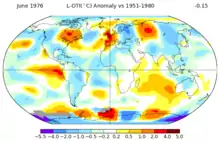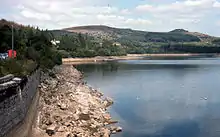1976 British Isles heat wave
The 1976 British Isles heat wave led to the second hottest summer average temperature in the UK since records began. At the same time, the country suffered a severe drought.[2][3] It was one of the driest, sunniest and warmest summers (June/July/August) in the 20th century, although the summer of 1995 is now regarded as the driest. Only a few places registered more than half their average summer rainfall. In the CET record, it was the warmest summer in that series. It was the warmest summer in the Aberdeen area since at least 1864, and the driest summer since 1868 in Glasgow.[4]
| Dates | 23 June – 27 August [1](66 days) | |
|---|---|---|
| Areas affected | British Isles | |
| Highest temperature | 35.9 °C (96.6 °F) in Cheltenham, Gloucestershire on 3 July | |

Heatwave and drought effects
Heathrow had 16 consecutive days over 30 °C (86 °F) from 23 June to 8 July[5] and for 15 consecutive days from 23 June to 7 July temperatures reached 32.2 °C (90 °F) somewhere in England. Furthermore, five days saw temperatures exceed 35 °C (95 °F). On 28 June, temperatures reached 35.6 °C (96.1 °F) in Southampton, the highest June temperature recorded in the UK. The hottest day of all was 3 July, with temperatures reaching 35.9 °C (96.6 °F) in Cheltenham.
The great drought was due to a very long dry period. The summer and autumn of 1975 were very dry, and the winter of 1975–76 was exceptionally dry, as was the spring of 1976; indeed, some months during this period had no rain at all in some areas.
The drought was at its most severe in August 1976 and in response parliament passed the Drought Act 1976.[6] Parts of the south west went 45 days without any rain in July and August. As the hot and dry weather continued, devastating heath and forest fires broke out in parts of Southern England. 50,000 trees were destroyed at Hurn Forest in Dorset. Crops were badly hit, with £500 million worth of crops failing. Food prices subsequently increased by 12%.[7]
Massive swarms of seven-spotted ladybirds (Coccinella septempunctata) occurred across the country, with the British Entomological and Natural History Society estimating that by late July 23.65 billion of them were swarming across the southern and eastern coasts of England. The population explosion occurred because a warm spring had meant there were many aphids, the ladybirds' food prey; as the hot weather dried the plants on which the aphids fed, the aphid populations collapsed, causing the ladybirds to swarm to try to find food elsewhere.[8]
In the last week of August, days after Denis Howell was appointed 'Minister for Drought', severe thunderstorms brought rain to some places for the first time in weeks. September and October 1976 were both very wet months, bringing to an end the great drought of 1975–1976.
The Haweswater reservoir had only 10% of its water left; people walked dryshod on its bed 60 feet below its normal water level. The site of the flooded village of Mardale Green was dry.[9]
In Ireland the temperature reached 32.5 °C (90.5 °F) in County Offaly on 29 June 1976.[10] There were also gorse fires in County Wicklow.

Health impact
The 1976 heatwave is understood to have been the cause of 20% 'excess deaths' and there were significantly more hospital emergency admissions from 24 June to 8 July 1976 than for the same period in 1975 or 1974.[11] This compares to 59% excess deaths for the 2003 heatwave.[12]
Ecological impact
The extensive fires paradoxically helped preserve many areas of heathland that had been becoming scrubland through natural succession because of reduced grazing pressure; the only long-term effect of the fires on Dorset heathlands was a change in the composition of scrub.[13] The impacts of the extended drought on mature trees, especially beech, were still evident in UK woodlands in 2013.[14]
Government response

The effect on domestic water supplies led to the passing of a Drought Act by parliament[6] and Minister for Drought, Denis Howell, was appointed.[15] There was widespread water rationing and public standpipes in some affected areas. Reservoirs were at an extremely low level, as were some rivers. The rivers Don, Sheaf, Shire Brook and Meers Brook (all in Sheffield) all ran completely dry, without a drop of water in any of them, as well as Frecheville Pond and Carterhall Pond (Carterhall Pond was permanently dry until 2007, when floods hit, and has not dried since ).
Longer term, the UK Department of the Environment realised it needed more information about the storage capacity and other properties of British aquifers, as sources of groundwater.
Comparisons
In the Central England Temperature series, 1976 is the hottest summer for more than 350 years. The average temperature over the whole summer (June, July, August) was 17.77 °C (63.99 °F), compared to the average for the unusually warm years between 2001–2008 of 16.30 °C (61.34 °F).[16]
The summer was so hot that it is embedded in the national psyche, with subsequent heatwaves in 1995,[17] 1997,[18] 2003, 2006[19] and 2018 all using 1976 as a benchmark.
See also
References
- http://www.trevorharley.com/weather_web_pages/british_weather_in_august.htm
- "The drought of 1976". BBC News. Retrieved 20 May 2011.
- Cox, Evelyn Cox (1978). The Great Drought of 1976. Hutchinson, Readers Union Group.
- "1975 - 1999". Booty.org.uk. Archived from the original on 3 October 2016. Retrieved 15 December 2016.
- "Hot spell - August 2003". Met Office. Archived from the original on 28 February 2011. Retrieved 15 December 2016.
- http://politicsuk.net (full text)
- "Archived copy". Archived from the original on 8 July 2009. Retrieved 1 January 2008.CS1 maint: archived copy as title (link)
- "Could the ladybird plague of 1976 happen again?". BBC News Online. 5 March 2016. Retrieved 15 December 2016.
- Ian, Harrison (2008). Britain from Above. London: Pavilion Books. p. 169. ISBN 978-1-862058-34-7.
- "Ireland's Hottest Day". RTÉ Archives. Retrieved 18 July 2018.
- "Mortality and Morbidity in Birmingham during the 1976 Heatwave". QJM. 1 January 1980. Retrieved 15 December 2016.
- Archived 30 June 2015 at the Wayback Machine
- "UK: The Role of Fire in the Ecology of Heathland in Southern Britain (IFFN No. 18 - January 1998)". Fire.uni-freiburg.de. Archived from the original on 16 July 2011. Retrieved 15 December 2016.
- "UK forests still feeling the impacts of 1976 drought - BBC News". Bbc.co.uk. 24 July 2013. Retrieved 15 December 2016.
- Longman, Phil (17 March 2004). "Was 1976 all it's cracked up to be?". BBC News. Retrieved 20 May 2011.
- Archived 7 April 2008 at the Wayback Machine
- "The summer of '76". BBC News. 20 March 1998. Retrieved 20 May 2011.
- "Government warns of water shortages". BBC News. 4 November 1997. Retrieved 20 May 2011.
- Coughlan, Sean (14 July 2006). "Is 2006 the new 1976". BBC News. Retrieved 20 May 2011.
Bibliography
- The Great Drought of 1976. Evelyn Cox (1978). Hutchinson, Readers Union Group, ISBN 0-09-133200-1